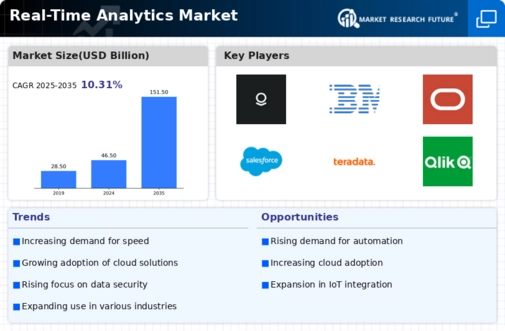Market Growth Projections
The Global Real-Time Analytics Market Industry is poised for substantial growth, with projections indicating a market value of 46.5 USD Billion in 2024 and an anticipated increase to 151.5 USD Billion by 2035. This growth trajectory suggests a compound annual growth rate (CAGR) of 11.34% from 2025 to 2035. Such figures underscore the increasing reliance on real-time analytics across various sectors, driven by technological advancements and the need for immediate insights. The market's expansion reflects a broader trend towards data-driven decision-making, highlighting the importance of real-time analytics in contemporary business environments.
Advancements in Technology
Technological advancements play a pivotal role in propelling the Global Real-Time Analytics Market Industry forward. Innovations in cloud computing, artificial intelligence, and machine learning facilitate the processing of vast amounts of data in real time. For example, cloud-based platforms enable businesses to access and analyze data from multiple sources seamlessly. This capability is crucial for sectors such as finance, where real-time analytics can detect fraudulent activities instantly. As technology continues to evolve, the market is expected to expand significantly, with projections indicating a value of 151.5 USD Billion by 2035, showcasing the potential for further growth driven by technological integration.
Enhanced Customer Experience
The emphasis on enhancing customer experience is a crucial factor driving the Global Real-Time Analytics Market Industry. Businesses are increasingly leveraging real-time data to understand customer behavior and preferences, allowing for personalized marketing strategies. For example, e-commerce platforms utilize real-time analytics to recommend products based on user interactions. This tailored approach not only improves customer satisfaction but also boosts sales. As companies prioritize customer-centric strategies, the demand for real-time analytics solutions is likely to grow, reflecting the industry's adaptability to changing consumer expectations.
Increasing Adoption of IoT Devices
The proliferation of Internet of Things (IoT) devices is a significant driver of the Global Real-Time Analytics Market Industry. As more devices become interconnected, the volume of data generated increases exponentially, necessitating real-time analytics for effective management. Industries such as manufacturing leverage real-time data from IoT sensors to monitor equipment performance and predict maintenance needs. This proactive approach not only enhances operational efficiency but also reduces downtime. The growing reliance on IoT technologies suggests that the market will continue to thrive, as organizations seek to harness the power of real-time analytics to optimize their operations.
Growing Demand for Real-Time Insights
The Global Real-Time Analytics Market Industry is experiencing a surge in demand for immediate insights across various sectors. Organizations are increasingly recognizing the value of real-time data in enhancing decision-making processes. For instance, businesses in retail utilize real-time analytics to optimize inventory management and improve customer experiences. This trend is reflected in the market's projected growth, with an estimated value of 46.5 USD Billion in 2024, indicating a robust appetite for solutions that provide timely information. The ability to analyze data as it is generated allows companies to respond swiftly to market changes, thereby gaining a competitive edge.
Regulatory Compliance and Risk Management
Regulatory compliance and risk management are increasingly influencing the Global Real-Time Analytics Market Industry. Organizations are compelled to adhere to stringent regulations, particularly in sectors like finance and healthcare. Real-time analytics provide the tools necessary to monitor compliance and mitigate risks effectively. For instance, financial institutions utilize real-time data to ensure adherence to anti-money laundering regulations. This focus on compliance is likely to drive market growth, as companies invest in analytics solutions to avoid penalties and enhance their risk management frameworks. As the regulatory landscape evolves, the demand for real-time analytics is expected to rise correspondingly.

























Leave a Comment